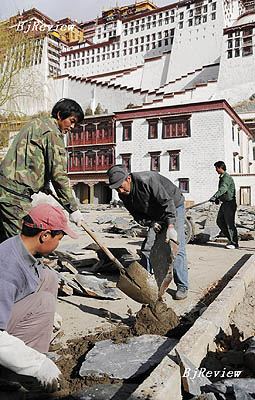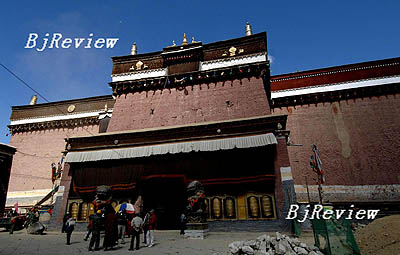|

Renovation work on Tibet's Potala Palace and Norbu Lingka has resumed as the weather gets warmer, according to a cultural relics official in the Tibet Autonomous Region (TAR).
Only a short period of the year is suitable for renovation work because of the high altitude and unfavorable weather conditions in Tibet, said Nyima Tsering, head of the TAR Cultural Relics Bureau. The bitter cold in winter affects the quality of renovation work so it has to be postponed until temperatures increase, he explained.
Renovation work on Sagya Monastery, the third key project besides the Potala Palace and Norbu Lingka, has not yet been resumed because it is at a higher altitude, he said. Weather conditions will determine when renovations there restart.
The Sagya Monastery, first built in 1073, has long enjoyed similar fame to the Dunhuang Grottoes, Gansu Province, for its large collection of Buddhist scriptures, valuable porcelain and vivid murals dating back nearly 1,000 years.
Work did not stop during the Lhasa riots on March 14, which is so far known to have claimed at least 18 civilian lives and caused 382 injuries, but the delivery of construction materials was delayed for a few days due to the traffic controls, he said.
Starting this year, China will appropriate about 570 million yuan ($81 million) for the protection and renovation of 22 top-priority cultural relics in Tibet.
Among this investment, 280 million yuan ($39 million) allocated by the State Development & Reform Committee is for the protection of Tashilhungpo Monastery, Nenying Monastery, Namseling Manor and a number of other cultural sites. A total of 290 million yuan ($40 million) from the Ministry of Finance will be pumped into renovation work at Jokhang Temple, Ramoche Monastery, Drepung Monastery, Sera Monastery, Samye Monastery and some other sites, according to Nyima Tsering, head of the TAR Cultural Relics Bureau.
Those 22 cultural relics sites include 15 key cultural relics protection sites and key protection monasteries as well as 7 historical relics, said Nyima Tsering.

"Renovation of the three major cultural heritage sites in Tibet, which will cost 330 million yuan ($46 million), is expected to be fully completed this year. Currently, another 570 million yuan ($79 million) has been invested in the protection of Tibet's key cultural relics during the 11th Five-Year-Plan (2006-10) period," he said.
A lead group office that coordinates the protection of Tibet's key cultural relics and sites was set up last April and 15 plans and approval works have so far been completed.
About 700-million-yuan ($97 million) investment has been allocated by the state government and the TAR local government to maintain about 1,400 monasteries, cultural heritage sites and sites for religious activities over the past two decades. | 